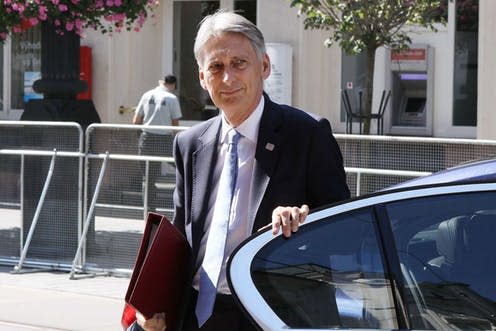Budget 2017: UK's driverless cars stuck on testing roundabout

The UK government is betting big on driverless cars with the chancellor, Philip Hammond, announcing plans to change regulation to allow developers to test autonomous vehicles on British roads.
Ahead of the Budget, Hammond – echoing his predecessor, George Osborne – said that “bold reforms” to get driverless cars on UK roads by 2021 would see the country leading the world in new technologies and infrastructure.
But, given the Silicon Valley-led effort to develop driverless cars, it’s going to be difficult for UK government-backed projects to make much impact – unless they have some breakthrough technologies under test. To date, however, there’s no public evidence to suggest that the UK is ahead of the pack.
Government support for driverless vehicles might be justified if its impact on the clogged up transport system is clearly beneficial. Autonomous vehicles would need to be demonstrably safer than their human-driven counterparts to be publicly acceptable – but the technology isn’t there yet.
If significant issues with automation can be ironed out, then higher safety rates should be achievable, given that most car crashes are due to human error. So we may expect a safety benefit from driverless cars and lower cost insurance. Beyond that, it seems likely that there will be two main impacts.
First, replacing the human driver with automation would drive down the cost of licensed taxis and private hire vehicles, enhancing their competitiveness. This is presumably why Uber – beset with regulatory issues relating to the employment status of its drivers – is so keen on this technology. Just recently, the company ordered 24,000 driverless cars from Volvo. Such robotic vehicles would fill the gap in service provision that exists between high-capacity, low cost public transport and low-capacity, high cost taxis.
Public transport proponents are anxious that autonomous vehicles will attract people away from buses, leading to gridlock. On the other hand, research suggests that the ready availability of automated taxis would probably reduce the appeal of owning a car, and robotic shared-use minibuses would allow door-to-door conveyance at reasonable charges. So, we can envisage a future in which the availability of shared-use autonomous vehicles fosters a shift away from private ownership in urban areas, with a beneficial impact on traffic congestion.
Second, private car ownership is likely to remain popular outside of cities. Driverless cars might be expected to allow new options, such as sending a vehicle home unoccupied, after delivering a passenger to their workplace. It’s then freed up for use by others living in the same household. This could reduce car ownership per household, but would increase the number of miles travelled in one vehicle.
Another option would be “parking on the move” – programming a car to cruise round the block while the passenger nips out to the shops. However, such unoccupied vehicles would add to traffic and worsen congestion in urban areas, so they would need to be regulated to give priority to occupied vehicles.
A key test for any new autonomous vehicle technology is its positive and negative impacts on traffic congestion. In the absence of evidence from deployment at scale, the outcome is uncertain and the UK government’s transport policy championing driverless vehicles is by no means a sure route to the future of mobility.
A fork in the road
The evolutionary approach to autonomous vehicles – pursued by the world’s car manufacturing giants – offers to relieve drivers of tedious tasks with technology such as adaptive cruise control, which regulates the speed and space to the vehicle ahead.
The revolutionary route, pioneered by Waymo (a brand owned by Google), dispenses with the driver entirely. Other US companies with disruptive approaches are actively developing and investing in driverless technologies, including Tesla and Uber.
But where does that leave the UK government’s pledge to be a world leader in an increasingly crowded market, especially given that big questions still hang over the technology’s deployment at scale?
There are two related reasons why the government might attempt to “pick a winner” of this kind: industrial policy and transport policy. If, as Osborne claimed, driverless cars represent “the most fundamental change to transport since the invention of the internal combustion engine”, then support for autonomous vehicles should form part of the UK government’s industrial strategy and transport policy.
In the past few years, the government has actively supported trials and future deployment of driverless vehicles on British roads. Projects are already underway in Bristol, Coventry, Greenwich and Milton Keynes; research and development is taxpayer funded; codes of practice for on-road testing have been published; and draft legislation has been introduced in parliament calling for vehicle insurance to cover both the motorist when driving as well as the car in automated mode.
But it’s the lack of clarity on the UK government’s transport policy that justifies cautious support of development, testing and deployment of driverless cars to improve research into the implications of what could yet turn out to be an important innovation for Britain’s roads.
Which brings us neatly back to the UK transport ministry’s bold statement: “These measures will help realise the chancellor’s vision that fully self-driving cars will be on UK roads in as little as three years.”
Traditional transport technologies based on mechanical and civil engineering develop quite slowly. In contrast, digital technologies are fast and disruptive. Autonomous vehicles are where the digital hare has to ride on the back of the mechanical tortoise, with as yet uncertain consequences for the speed of travel.
This article was originally published on The Conversation. Read the original article.

David Metz does not work for, consult, own shares in or receive funding from any company or organisation that would benefit from this article, and has disclosed no relevant affiliations beyond their academic appointment.

 Yahoo News
Yahoo News 